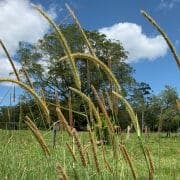PSSM – how do the different forms affect how you should feed?
How can FeedXL help your horse with PSSM?
Polysaccharide Storage Myopathy (PSSM) is an area of growing information. Dr Stephanie Valberg and colleagues at Michigan State University lead this movement and most information and nutritional guidelines we use today can be attributed to research performed by Dr Valberg and colleagues.
The purpose of this article is to summarise the most current dietary recommendations and explain how FeedXL can help manage the nutrition of horses diagnosed with the various forms of PSSM, including Type 1 PSSM, Type 2 PSSM and MFM, based on findings from research in this area.
Identifying your horse has PSSM in FeedXL
With limited testing for specific types of PSSM in some countries, horses with PSSM symptoms are more broadly diagnosed under the one umbrella of PSSM. Without a specific diagnosis via genetic testing (currently only validated for Type 1 PSSM) or muscle biopsy, caution should be used for all PSSM horses and low NSC diet implemented to see if improvements occur.
When using FeedXL, the first step is to tick ‘Tying Up (PSSM)’ when entering your horse’s details. Based on this, FeedXL will help you choose safe forages, feeds and supplements based on non-structural carbohydrate (NSC) content of each individual ingredient or whether the ingredient contains grain, grain by-products or high sugar ingredients eg. molasses.
Ingredients are colour coded as:
BLACK = Probably Suitable – Known NSC less than 12%.
PURPLE = Possibly Suitable – Does not contain grain or grain by-products but NSC content is unknown and may contain other high sugar ingredients.
ORANGE – Maybe Suitable – Known NSC content between 12% and 15%.
RED – Probably Unsuitable – Known NSC content >15% or unknown NSC content but contains grain or grain by-products.

Designing a suitable diet in FeedXL
Forage
Forage is an essential part of any horse’s diet but for those with PSSM, it is an important area to focus on as part of your horse’s diet. A minimum forage intake at 1.5-2% body weight per day (7.5-10kg for a 500kg horse) is advised.
Forage analysis is highly recommended to ensure selection of appropriate forage based on digestible energy, crude protein, starch and sugar (WSC) levels. By adding your forage analysis into FeedXL, you can confidently assess the need for additional energy and protein sources and ensure mineral and vitamin requirements are being met.
Specific dietary recommendations
Type 1 PSSM
For horses diagnosed with Type 1 PSSM, research has shown that providing a low NSC diet (with each individual ingredient less than 12% NSC) is essential. Fat inclusion at 15-20% of total digestible energy is recommended (excluding overweight horses).
For easy keepers, focusing on use of lower energy forages in the diet will allow for weight loss if necessary. Inclusion of a good quality protein source may be required to meet protein requirements and in this case a grain free low NSC balancer pellet can be used to achieve a balanced diet. If adequate amounts of forage are in the diet and room permits for additional calories, oil may be added.
For horses with higher energy requirements, commercially available low starch high fat feeds are available. Alternatively, using a combination of highly digestible fibre and high fat ingredients can be used to meet energy and protein requirements. Examples are beet pulp, soybean hulls, lupins (unique to Australia), copra meal, full fat soybean and oils.
Type 2 PPSM
With the exact cause of Type 2 PSSM currently unknown, for the most part dietary recommendations remain the same as for Type 1 PSSM horses.
For easy keepers, focus on supplying good quality protein sources eg. full fat soybean or whey protein concentrate are recommended. This contrasts with supplying excessive amounts of crude protein ie. provide quality not quantity.
If more energy is required, fat/oil supplementation should be used to meet energy requirements with less emphasis on supplying a certain percentage of DE from fat sources.
MFM (Myofibrillar Myopathy)
MFM is technically a condition in its own right rather than a form of PSSM. However, some horses previously diagnosed with Type 2 PSSM, may in fact have MFM.
The latest recommendations for MFM focus on use of a high-quality protein, moderate starch diet (ingredients with up to 20-30% starch) where additional energy is required and dietary fat of 4-8%.
For easy keepers, focus should be on supplying adequate forage and inclusion of high-quality protein. Due to the role cysteine may play in this condition, use of whey protein concentrate which is rich in cysteine as a dietary protein source is recommended.
| Dietary Consideration | Diagnosed Condition | ||
| Type 1 PSSM | Type 2 PSSM | MFM | |
| Low NSC | Always | Sometimes | Not Essential |
| Addition/use of good quality protein sources | Not essential | Yes | Essential |
| Inclusion of starch or sugar | Never | Sometimes | Yes – if necessary |
| Fat supplementation | Beneficial – 15-20% | Not essential | Limited – dietary fat of 4-8% |
| Elevated vitamin E & selenium | Beneficial* | Beneficial* | Beneficial* |
| Other minerals & vitamins | Meet requirements | Meet requirements | Meet requirements |
*FeedXL RDI for vitamin E and selenium is elevated when ‘Tying Up (PSSM)’ is ticked on your horse’s details page.
Additional resources
Selecting the best quality protein https://feedxl.com/30-understanding-protein-quality/.
Choosing a suitable oil https://feedxl.com/42-oils-good-or-bad/
Summary
While diet only forms part of the management for PSSM horses, exercise being the other major component, getting it right can greatly minimise the symptoms PSSM horses experience. Dietary focus should centre around providing a high forage diet with suitable levels of energy, protein, starch and sugar for your horse.
FeedXL helps to take the guess work out of supplying adequate good quality protein in the diet, can assist in calculating the amount of fat in diets and gives peace of mind knowing the diet is meeting mineral and vitamin requirements.
Do you have a question or comment? Do you need help with feeding?
We would love to welcome you to our FeedXL Horse Nutrition Facebook Group. Ask questions and have them answered by PhD and Masters qualified equine nutritionists and spend time with like-minded horse owners. It’s free!
Click here to join the FeedXL Horse Nutrition Facebook Group











